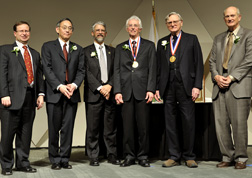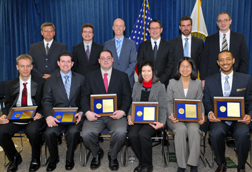Presidential Awards Celebrate Energy Research at Different Stages of Scientists' Careers
Science and engineering have shaped societies and sparked a revolution in thought, exploration, and innovation. Monumental moments like the Gutenberg press, Anton van Leeuwenhoek’s microscope, Einstein’s exploration of the photoelectric effect, and the sequencing of the human genome have changed how people look at the world in which they live.
The Department of Energy Office of Science (DOE) is the single largest supporter of basic research in the physical sciences in the United States. This past week, the Agency provided awards to two scientists for their lifetime achievement in energy science and a group of early career scientists for exceptional work spanning improvements in hydrogen storage, modeling of subsurface hydrologic processes, environmentally responsible chemistry, and excellence in teaching and mentoring the next generation of scientists.
On January 12, 2010, the Office of Science bestowed the Enrico Fermi award to John Bannister Goodenough, a professor at the University of Texas at Austin, and Siegfried S. Hecker, co-director of the Stanford University Center for International Security and Cooperation (CISAC) in the Freeman Spogli Institute for International Studies.
"The 2009 Enrico Fermi Award will go to two scientists who have selflessly devoted themselves to our nation's energy and national security challenges," DOE Secretary Steven Chu said. "These two individuals are pioneers in innovative research and I want to thank them for their work and congratulate them on this award."
Goodenough was awarded for his lasting contributions to materials science and technology, especially for the science underlying lithium-ion batteries, which helped launch the wireless revolution with the first cell phones, laptop computers, and mp3 players. “I had the good fortune to have the opportunity to build a bridge between physics and both solid-state and electrochemistry to achieve some targeted technological goals, as well as to pursue fundamental studies in the field of solid transition-metal compounds” recalled Goodenough.
 Photo Credit - Ken Shipp
Photo Credit - Ken Shipp
2009 Enrico Fermi Ceremony. (from the left) Dr. Steven Koonin, Secretary of Energy Steven Chu, Dr. John Holdren, Dr. Siegfried S. Hecker (awardee), Dr. John Bannister Goodenough (awardee), and Dr. William Brinkman.
Awarded for his contributions to plutonium metallurgy and for his energetic and continuing efforts to reduce the danger of nuclear weapons around the globe, Siegfried Hecker stated, "I have been most fortunate to have worked with inspirational people at great institutions such as the Los Alamos National Laboratory and Stanford University." "I have been able to pursue my passion for science and technology, especially in the nuclear arena, and how these affect international security."
The Fermi award, established in 1956, honors the memory of Enrico Fermi, leader of the group of scientists who, on Dec. 2, 1942, achieved the first self-sustained, controlled nuclear reaction at the University of Chicago. The award perpetuates the memory of this brilliant scientist by recognizing scientists whose careers have been marked by continued outstanding achievements in the field of energy.
The following day, 100 researchers from nine Federal Agencies were the recipients of the Presidential Early Career Awards for Scientists and Engineers (PECASE), the highest honor bestowed by the United States government on young professionals in the early stages of their independent research careers.
The Department of Energy awarded 12 early career scientists, including:
Cecilia R. Aragon, Lawrence Berkeley National Laboratory
Gary A. Baker, Oak Ridge National Laboratory
Joshua A. Breslau, Princeton Plasma Physics Laboratory
Gianluigi Ciovati, Thomas Jefferson Lab National Accelerator Facility
Stefan P. Gerhardt, Princeton Plasma Physics Laboratory
Lynford L. Goddard, University of Illinois at Urbana-Champaign
Jason Graetz, Brookhaven National Laboratory
Jeffrey B. Neaton, Lawrence Berkeley National Laboratory
Thao D. Nguyen, Johns Hopkins University
Paul Sorensen, Brookhaven National Laboratory
Alexandre M. Tartakovsky, Pacific Northwest National Laboratory
Ivan Vitev, Los Alamos National Laboratory
 Photo Credit - Ken Shipp
Photo Credit - Ken Shipp
DOE PECASE Awardees.
PECASE embodies the high priority the Administration places on producing outstanding scientists and engineers to advance the nation’s goals and contribute to all sectors of the economy.
“You have been selected for this honor not only because of your innovative research, but also for your demonstrated commitment to community service and public outreach,” President Obama said in a letter to the winners. “Your achievements as scientists, engineers, and engaged citizens are exemplary, and the value of your work is amplified by the inspiration you provide to others.”
PECASE was established by President Clinton in February 1996 and is coordinated by the Office of Science and Technology Policy within the Executive Office of the President. Winning scientists and engineers receive up to a five-year research grant to further their study in support of critical government missions.
This article was written by Stacy W. Kish

